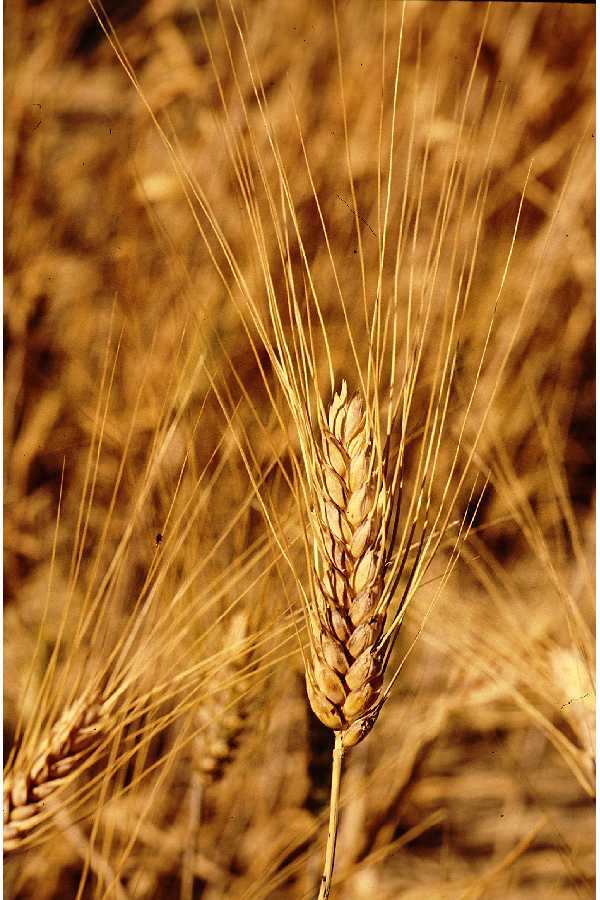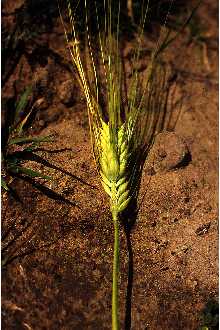![]() Species |
Rice |
Maize |
Wheat |
Barley |
Oats |
Foxtail Millet |
Pearl Millet |
Rye |
Sorghum |
Wild Rice |
Brachypodium |
Oryza Species |
Grape |
Arabidopsis
Species |
Rice |
Maize |
Wheat |
Barley |
Oats |
Foxtail Millet |
Pearl Millet |
Rye |
Sorghum |
Wild Rice |
Brachypodium |
Oryza Species |
Grape |
Arabidopsis
 Foxtail barley Photo courtesy Jennifer Anderson @ USDA-NRCS PLANTS Database |
 Barley Photo courtesy Robert Soreng @ USDA-NRCS PLANTS Database |
 Barley Photo courtesy Robert Soreng @ USDA-NRCS PLANTS Database |  Smooth barley Photo courtesy W.L. Wagner @ USDA-NRCS PLANTS Database |
In 2005 barley ranked fourth for cereal production (see Gramene Cereals). There are many types of barley, many different uses for it, and a long history of its importance to mankind.
Cultivated barley is a member of the genus Hordeum. Cultivated barley is descended from wild barley (Hordeum spontaneum) (12, 13), which still grows wild in the Middle East (12). Both the cultivated and wild forms of barley are diploid species, with 2n=14 (6, (12). Among the wild Hordeum, there are also tetraploid, and hexaploid species (6). Cultivated barley is an annual plant, but there are also many other perennial species (6).
The exact origin of barley is debatable, possibly originating in Egypt, Ethiopia, the Near East or Tibet (3). However, we are fairly certain that barley was among the earliest cultivated grains, around the same time as domestication of wheat (see Wheat Species pages).
Barley was grown in the Middle East prior to 10,000 BC (6, 12, 13), but barley's cultivation in China and India probably occurred later (6). Barley was grown on the Korean Peninsula by 1500-850 BC (12, 13) along with millet, wheat, and legumes (12).
Six-rowed barley did not come about until after 6000 BC (13). In ancient Egypt (3200 BC to 30 BC) barley bread and beer (made from barley) constituted a complete diet (12).
See also "History for kids - Barley".
Barley has many different varieties, and there are many ways to classify barley.
One way to classify barley is to identify it by whether there are two, four or six rows of grains on the head (10, 12, 13). Six row barley can produce 25-60 grains, while two-row barley produces 25-30 grains (4). Four-row barley is actually a loose six-row barley (4), so many sources only differentiate between two- and six-row varieties. Wild barley is two-row (12), and most cultivated barley is of the six-row type.
Another way to classify barley is to describe the beards (awns) covering the kernels (10). In the barley germplasm database awns are described along the following morphology (1):
- Long awned
- Short awned
- (Normal) hooded
- Elevated hooded,
- Subjacent hooded
- Long awned in central row, and awnletted or awnless in lateral rows
- Short awned in central row, and awnletted or awnless in lateral rows
- Awnless or awnletted in central and lateral rows
- Elevated hoods in central row, and awnless in lateral rows
Barley can also be described by
(Some hulless cultivars are resulting in more digestible, higher-protein feed, especially for swine and poultry. (8) )
- hulled or hulless (naked) (6, 8, 10, 12),
- feed or malt type,
- height (dwarf),
- seed color (colorless, white, yellow, blue) (6)
Still others classify barley into 4 types based on geography: Manchurian types, Coast Types, Hannchen types, or Compana-Smyrna types (8).
References:Barley is grown for many purposes, but the majority of all barley is used for animal feed, human consumption, or malting (6, 10, 12, 13). High protein barleys are generally valued for food and feeding, and starchy barley for malting (3).
Animal feedGrains for human consumption.Barley is basically a livestock feed (6, 8, 10, 12, 13) and is a good source of protein(10). It can be rolled, ground, flaked or pelleted (6), but by-products from malting and brewing are also used in feed production (13). Barley is also used for pasture, greenfeed, hay, roughage and bedding (3, 13).
MaltingMost barley used for food is either pearled barley or barley flour. (10, 13) Prior to the 1500's barley flour was the main ingredient for breads (3). For more information on barley nutrition, see Nutrition and Recipes.
Other usesThe second most important use of barley is for malt (6), and in the US there are price premiums for malting barley (10). Malt is used to produce beer, distilled alcohol, malt syrup, malted milk, flavorings and breakfast foods (6, 8, 10, 12, 13).
Malting barley is a high-quality barley, and malting barley is frequently also used for animal feed and human nutrition (8). Both two- and six-row varieties are used for malting (10) - six-rowed varieties are ideal for beer, and two-rowed are suited for pure malts (12, 13), but despite these generalizations it is important to remember that differences in malting and brewing practices and consumer preferences differ across the globe (6). Both hulless cultivars and four-row varieties are unsuitable for malt (8, 12).
Malting can be described as "controlled sprouting" (6). For indepth information on the malting process see:
Barley, in various forms, is used in folk remedies for cancers and various other ailments; it is also easily digestible for invalids and convalescents; and barley straw is used for making hats, packaging, and pulp (3).